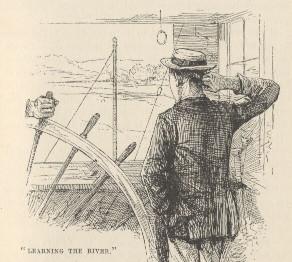December 13 Monday – Sam and Horace Bixby left St. Louis on the Aleck Scott (709 tons) under Captain Robert A. Reilly. Sam remarked on the Aleck Scott: I will remark, in passing, that Mississippi steamboatmen were important in landsmen’s eyes (and in their own, too, in a degree) according to the dignity of the boat they were on. For instance, it was a proud thing to be of the crew of such stately craft as the ‘Aleck Scott’ or the ‘Grand Turk.’ Negro firemen, deck hands, and barbers belonging to those boats were distinguished personages in their grade of life, and they were well aware of that fact, too. – Life on the Mississippi [MTL 1: 14]. The Aleck Scott was the last steamboat Sam served on as cub pilot. His next assignment was pilot on the Alfred T. Lacey.
December 21 Tuesday– The Aleck Scott arrived in New Orleans.
December 24 Friday – The Aleck Scott left New Orleans.
January 1 Saturday – The Aleck Scott arrived in St. Louis.
January 4 Tuesday – The Aleck Scott left for New Orleans.
January 11 Tuesday – The Aleck Scott arrived in New Orleans.
January 15 Saturday – The Aleck Scott left for St. Louis.
January 27 Thursday – The Aleck Scott arrived in St. Louis.
February 1 Tuesday – The Aleck Scott left for New Orleans.
February 11 Friday – The Aleck Scott arrived in New Orleans
February 16 Wednesday – The Aleck Scott left for St. Louis
February 27 Sunday – The Aleck Scott arrived in St. Louis
March 1 Tuesday – The Aleck Scott left for New Orleans.
March 8 Tuesday – The Aleck Scott arrived in New Orleans
March 9 and 11 Friday – In New Orleans, Sam began a long letter to sister Pamela Moffett, that he finished on Mar. 11. He wrote of the Mardi Gras, and Maria Piccolomini, an Italian “princess” singer Here, in part: . . . . [first part not extant] beginning of Lent, and all good Catholics eat and drink freely of what they please, and, in fact, do what they please, in order that they may be the better able to keep sober and quiet during the coming fast. It has been said that a Scotchman has not seen the world until he has seen Edinburgh; and I think that I may say that an American has not seen the United States until he has seen Mardi-Gras in New Orleans. I posted off up town yesterday morning as soon as the boat landed, in blissful ignorance of the great day. At the corner of Good-Children and Tchoupitoulas streets, I beheld an apparition!—and my first impulse was to dodge behind a lamp-post. It was a woman—a hay-stack of curtain calico, ten feet high—sweeping majestically down the middle of the street (for what pavement in the world could accommodate hoops of such vast proportions?) Next I saw a girls of eighteen, mounted on a fine horse, and dressed as a Spanish Cavalier, with long rapier, flowing curls, blue satin doublet and half-breeches, trimmed with broad white lace—(the balance of her dainty legs cased in flesh-colored silk stockings)—white kid gloves—and a nodding crimson feather in the coquettishest little cap in the world. She removed said cap and bowed low to me, and nothing loath, I bowed in return—but I could n’t help murmuring, “By the beard of the Prophet, Miss, but you’ve mistaken your man this time—for I never saw your silk mask before—nor the balance of your costume, either, for that matter.” And then I saw a hundred men, women and children in fine, fancy, splendid, ugly, coarse, ridiculous, grotesque, laughable costumes, and the truth flashed upon me—“This is Mardi-Gras!” It was Mardi-gras—and that young lady had a perfect right to bow to, shake hands with, or speak to, me, or any body else she pleased. The streets were soon full of “Mardi-gras,” representing giants, Indians, nigger minstrels, monks, priests, clowns,— every birds, beasts,—everything, in fact, that one could imagine. The “free-and-easy” women turned out en masse—and their costumes and actions were very trying to modest eyes. The finest sight I saw during the day was a band of twenty stalwart men, splendidly arrayed as Comanche Indians, flying and yelling down the street on horses as finely decorated as themselves. It was worth going a long distance to see the performances of the day—but bless me! how insignificant they seemed in comparison with those of the night, when the grand torchlight procession of the “Mystic Krewe of Comus” was added. …[MTL 1: 87-91].
Note: the Krewe was established in 1856; prior to that the celebrations was exclusively Catholic, informal, and not regular. Six Anglo businessmen met in a secret society to improve Mardi Gras, inspired by Milton’s Comus. The torchlight procession was one of their additions. The Aleck Scott left for St. Louis.
March 19 Saturday – The Aleck Scott arrived in St. Louis
March 21 Monday – The Aleck Scott left for New Orleans.
March 27 Sunday – The Aleck Scott arrived in New Orleans
March 31 Thursday – The Aleck Scott left for St. Louis
April 8 Friday – The Aleck Scott arrived in St. Louis
Granted a Pilots License:
April 9 Saturday – Sam was granted a license as a full steamboat pilot from the Department of Commerce in St. Louis. Until May 1861, Sam had the “best job in the world.”
Note: Until copies of Sam’s pilot license surfaced in the late 1930s, it was thought by Paine, DeVoto and others (from Sam’s autobiographical estimates of eighteen months from his apprenticeship under Bixby,) that the date was Sept. 9, 1858. Sam may have recollected being allowed to pilot crafts without passengers prior to the issuance of his license, which would have been lawful at that time [The Twainian, Nov. 1939].
